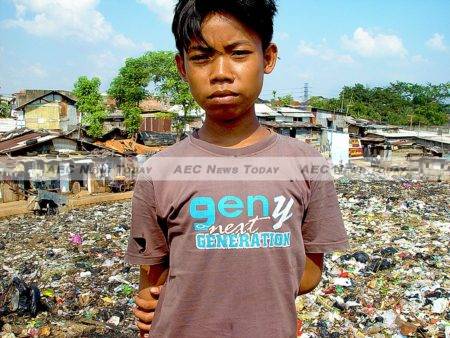Fifteen years of sustained economic growth in Indonesia have helped to reduce poverty and create a growing middle class.
However, growth over the past decade has primarily benefited the richest 20 per cent and left behind the remaining 80 per cent of the population—that is more than 205 million people.
Rasma, who sells ice on a cart in the country’s capital, Jakarta, is among those who are still left behind. Despite working from 4am to 10pm every day, Rasma still finds it difficult to make ends meet in supporting his family.
“I see that Jakarta has developed in the last few years, but I haven’t developed at all,” he said.
The Indonesian people are concerned that inequality is climbing fast.
Indonesia’s level of inequality is now considered to be relatively high and climbing faster than most of its East Asian neighbors.

Between 2003 and 2010, consumption per person for the richest 10 per cent of Indonesians grew at over 6per cent per year after adjusting for inflation. But for the poorest 40 per cent, consumption grew by less than 2 per cent per year.
The result? A sharp increase in Indonesia’s Gini coefficient over the past 15 years, increasing from 30 in 2000 to 41 in 2013.
Indonesians are concerned. A 2014 survey on public perceptions of inequality report found that most Indonesians consider income distribution in Indonesia to be “very unequal” or “not equal at all”; these respondents are urging government action.
“I feel conditions now are unfair,” said Nandang, a casual agriculture worker.
“The poor continue to have a hard life, while those who are already rich can easily get richer. If the government can do something to help, I would love to get a decent job.”
Indeed, the consequences of doing nothing may be grave: a likely slowdown in economic growth and poverty reduction, compounded by increasing risk for conflict.
Sixty one per cent of respondents are willing to accept lower economic growth in exchange for lower inequality.
Four main drivers of inequality in Indonesia
The government has laid out targets in the current Medium Term Development Plan for reducing Indonesia’s Gini Coefficient down from 41 to 36 by the year 2019.
In order to successfully achieve these targets, Indonesia must address the four main drivers of inequality in Indonesia:
- Inequality of opportunity. The fate of poorer children can be influenced by where they are born, or the education status of their parents – an unfair start in life can lead to less opportunities through the life cycle. At least one-third of inequality is due to factors outside an individual’s control.
- Inequality in the labor market. High-skilled workers receive increasing wages, and the rest of the workforce has few opportunities to develop skills and are trapped in low-productivity, low-wage informal jobs.
- High wealth concentration. The elite are benefiting from the possession of financial assets that drives inequality higher both today and in the future.
- Unequal resilience to shocks. Shocks disproportionately affect poor and vulnerable households, eroding their ability to earn incomes and invest in needed health-care and education.
Options to tackle Indonesia’s inequality
High inequality is not inevitable. Public policies can help Indonesia to break the intergenerational cycle of inequality by tackling those drivers of inequality.
For example, Brazil’s Gini coefficient fell by 14 points after a concerted effort to reduce inequality through fiscal policy. In contrast, based on 2012 data, Indonesia’s fiscal policy only reduced the Gini by 3 points.
Options of government action for Indonesia include:
- Improving local service delivery. A key to a better start for the next generation lies in enhanced local service delivery, which can improve health, education and family planning opportunities for all.
- Strengthening social protection programs such as conditional cash transfers and education subsidies.
- Promoting skills training opportunities for the workforce.
- Promoting better jobs.
- Ensuring protection from shocks.
- Using taxes and government spending to reduce inequality.
- Implementing a fairer taxation system.
- Improving compliance in personal income tax collection.
There is strong public support for social protection policies that provide direct assistance to the poor and near-poor. More than half of survey respondents believe poverty can be caused by factors beyond an individual’s control, such as coming from a poor family or having bad luck. Nearly half of all respondents support social protection programs as a key policy measure.
Download Indonesia’s Rising Divide
This article first appeared on the World Bank website as Indonesia’s Rising Divide and is reproduced here with its approval.
Feature video World Bank
Related:
- Inequality in Indonesia at record levels: World Bank (Channel NewsAsia)
- Inequality poses threat to Indonesia’s GDP growth (The Jakarta Post)
- Indonesia Still a Long Way from Closing the Wealth Gap (Inter Press Service)
- Income inequality high, economic inequality higher (The Jakarta Post)
The World Bank Group consists of: The International Bank for Reconstruction and Development, The International Development Association, The International Finance Corporation, The Multilateral Investment Guarantee Agency, and The International Centre for Settlement of Investment Disputes.
By 2030 The World Bank aims to:
1. End extreme poverty by decreasing the percentage of people living on less than $1.25 a day to no more than 3%.
2. Promote shared prosperity by fostering the income growth of the bottom 40% for every country.
It aims to achieve this by providing low-interest loans, zero to low-interest credits, and grants to developing countries.
Latest posts by The World Bank (see all)
- Navigating COVID-19’s shock to the Malaysian economy – June 21, 2020
- Pilot study finds IoT AWD feasible for smallholder farmers in Vietnam – June 20, 2020
- Digital services in Vietnam thrive during pandemic, now for the next step (video) – May 31, 2020
- Improving Indonesia’s rice production through improved data collection – November 17, 2019

